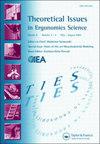‘‘Patients and clinicians perspectives on conventional and proprioceptive derivation approach’’: focus on learning and experiencing new skills
IF 1.4
Q4 ERGONOMICS
引用次数: 0
Abstract
Abstract Background & Objective Recent studies have shown that over 60% of dentists have any musculoskeletal disorders during their professional life. This study aimed to evaluate the effect of comfort levels of patients and clinicians while performing standard oral prophylaxis by ultrasonic scaling. Methods A questionnaire was distributed among the patients and clinicians to record their perceptions on comfort levels, treatment satisfaction and efficiency levels on both conventional and Pd. Fifty Patients were included in group A, those in which non-surgical periodontal therapy was done in any two quadrants on a conventional dental chair. Group B consisted of 50 Patients, those in which non-surgical periodontal treatment was done in other two quadrants on Pd support. Results Positive and negative aspects towards both the approaches by clinicians and patients regarding comfort levels, efficiency, and satisfactory levels were assessed and were more related to the Pd method. Clinicians are more comfortable when they used Pd approach, and everyone liked it. Conclusions By following the Pd concept in dentistry, one can increase the longevity of dentists to work in their profession mainly by altering the workspace/environment and changing into Pd support instead of a dental chair.“患者和临床医生对传统和本体感觉推导方法的看法”:专注于学习和体验新技能
摘要背景与目的最近的研究表明,超过60%的牙医在职业生涯中有任何肌肉骨骼疾病。本研究旨在评估通过超声洁治进行标准口腔预防时患者和临床医生的舒适度的影响。方法在患者和临床医生中分发问卷,记录他们对常规和Pd的舒适度、治疗满意度和效率水平的看法。50名患者被纳入A组,在常规牙科椅上的任何两个象限进行非手术牙周治疗。B组由50名患者组成,其中在Pd支持的其他两个象限进行非手术牙周治疗。结果临床医生和患者在舒适度、效率和满意度方面对两种方法的积极和消极方面进行了评估,并且与Pd方法更相关。临床医生在使用Pd方法时会更舒适,每个人都喜欢它。结论通过在牙科中遵循Pd概念,可以延长牙医在其职业中工作的寿命,主要是通过改变工作场所/环境,换上Pd支架而不是牙科椅。
本文章由计算机程序翻译,如有差异,请以英文原文为准。
求助全文
约1分钟内获得全文
求助全文

 求助内容:
求助内容: 应助结果提醒方式:
应助结果提醒方式:


